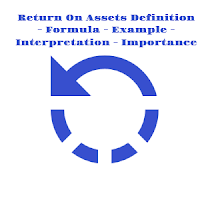Return On Assets Definition - Formula - Example - Interpretation - Importance
What is Return On Assets
Return On Assets means that how much efficient the management of the company is in managing the total assets of the company to generate revenues for the company. The ratio is used to
judge the performance of the management of the company in efficient use of business’s resources (Assets) to generate profits (Income) for the business.
Return On Assets Formula
It is the ratio of Net Income To Total Assets. Mathematically, we can write as:
Return On Assets = Net Income / Total Assets
Here Net Income is obtained from Income Statement of the Company, while Total Assets include both Current Assets And Non Current Assets and these are obtained from the Balance Sheet of the Company. This ratio is expressed in term of percentage (%).
Example
Suppose, from the income statement of the company, net income is Rs. 500000 while Total Assets are Rs. 1000000, then the ratio is:
500000 / 1000000 = .5
Interpretation / Analysis
The more the Return on Assets Ratio (ROA) is, the more the company is able to manage its assets to generate profits on invested amount in the business. But, you should remember that
the interpretation depends upon the particular industry in which the company is operating. Otherwise, the reliable and true comparison is not possible.
Importance / Significance
This ratio tells the investors that how well effective it is for them to invest in the company as this ratio shows the efficiency of the management in managing the assets to generate
profits on invested amount in the business.
It is all about Return On Asset Ratio Definition, its formula, example, Interpretations and Importance.

Comments